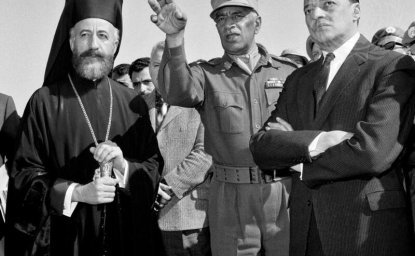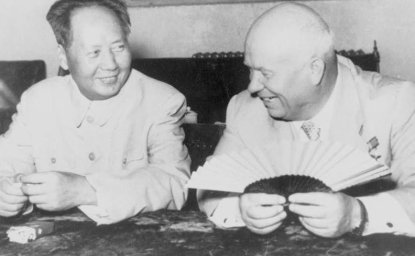In 1989, when the Soviet empire was  dissolving and the great symbol of the war, the Berlin Wall, was crumbling, today’s high school students were either just born or barely out of diapers. For these students, talk of war evokes television images of “smart bombs” and surface to air missiles soaring over a dark Baghdad sky while an embedded CNN journalist reports from a hotel rooftop. The concept that today’s Russia was once the “evil empire” and that Americans lived with the constant, yet quiet threat of nuclear annihilation, is probably pretty hard to fathom for your average 16-year old, and equally challenging to teach them about.
dissolving and the great symbol of the war, the Berlin Wall, was crumbling, today’s high school students were either just born or barely out of diapers. For these students, talk of war evokes television images of “smart bombs” and surface to air missiles soaring over a dark Baghdad sky while an embedded CNN journalist reports from a hotel rooftop. The concept that today’s Russia was once the “evil empire” and that Americans lived with the constant, yet quiet threat of nuclear annihilation, is probably pretty hard to fathom for your average 16-year old, and equally challenging to teach them about.
Understanding the Cold War, a war that determined geopolitics for 40 years, is critical to learning modern global history and to understanding its legacy for current politics. To assist today’s high school history teachers in educating their students about this important period in history, the Cold War International History Project teamed up with George Washington University and other Cold War experts last month for the second summer institute for teachers called “Teaching the New Cold War History.” Funded by a grant from the National Endowment for the Humanities, the two-year projects’s primary goal is to build lasting partnerships with American high school teachers in order to develop an interactive teaching tool that will contain the most recent cutting edge scholarship on the Cold War as well as a wealth of classic and important documentary resources.
 During this summer’s institute, teachers were asked to test a beta version of the new innovative segment of the CWIHP website for high school students--“The Cold War Files—Interpreting History Through Documents.” The website is designed to teach high school students the big topics of the Cold War through recently released primary source documents from both sides of the conflict, enabling the students to gain a balanced perspective and to develop advanced skills in critical thinking. This summer’s class of teachers built on the work of last summer's class, who largely determined the content and navigation for the site.
During this summer’s institute, teachers were asked to test a beta version of the new innovative segment of the CWIHP website for high school students--“The Cold War Files—Interpreting History Through Documents.” The website is designed to teach high school students the big topics of the Cold War through recently released primary source documents from both sides of the conflict, enabling the students to gain a balanced perspective and to develop advanced skills in critical thinking. This summer’s class of teachers built on the work of last summer's class, who largely determined the content and navigation for the site.
“What makes this site unique is the joint effort used to develop it. The teachers will provide their years of classroom experience and pedagogical knowledge to help shape the material so that it is engaging to the students. CWIHP will provide access to the most recent sources in Cold War history that high school classrooms and textbooks simply cannot keep up with,” says Christian Ostermann, director of the Cold War International History Project.
The teachers, representing urban, rural, and suburban school districts from 13 states, were selected through an application process. This summer, four teachers from last year’s class returned to help build continuity and to assist the nine new teachers. Although the institute concluded in July, the project is an ongoing partnership as the teachers will further field test the site with their students, the ultimate judges of its effectiveness.
The teachers spent each morning of the institute listening to presentations from Cold War scholars. For Shelley Jacobson, a teacher at Blind Brook High School in Rye Brook, New York and one of the returning teachers, Hope Harrison’s presentation on the Berlin Wall was a highlight. “The scholars were not condescending. Instead, there’s a good amount of give and take. For us, this is an opportunity to talk to people who are in the field doing the research.”
In her class, Jacobson covers Korea, Berlin, and the Cuban Missile Crisis and eagerly awaits the new Cold War Files site. “I recently did a project with my students on Reagan’s foreign policy and the current CWIHP website (cwihp.si.edu) was useful. To have all of the information and documents in one place [on the new site] will be great.”
What makes teaching Cold War history even more challenging is that the history from this period is constantly being revised and reinterpreted as new evidence comes to light. This is where the Wilson Center’s Cold War International History Project plays its most important role. For the past decade, CWIHP’s primary mission has been to facilitate access to formerly inaccessible archives and disseminate the findings from the archives of the former Communist world. The Project supports the full and prompt release of historical materials by governments on all sides of the Cold War, and seeks to accelerate the process of integrating new sources, materials, and perspectives from non-U.S. archives.
Tom Brannan, a teacher of world history at George C. Marshall High School in Fairfax, Virginia underscored “the value of GW and CWIHP in bringing these valuable resources to the high school level. [The cutting edge] in Cold War history is based on documents released by the countries formerly in the Communist bloc and by NSA declassified documents from western sources. The new Cold War history is document based. Now primary source documents are not only in the hands of scholars, but also high school students.”
One of the main learning objectives of the website is to use primary source documents and to critically analyze how history itself is developed.
“Primary matter is hard for high school students to use. They need to be taught how to place the documents within a broader context of what happened,” says Nancy Meyers, Project Associate at the Cold War International History Project and the lead on the website initiative. “We want students to feel they can take control of their own history, and get excited about it--that history is not just a matter of dates, it is a living thing.”
For updates on the website's progress, please visit http://cwihp.si.edu. For more information on the project, contact Nancy Meyers at 202/691-4110 or meyersna@wwic.si.edu.
This article was written by Lauren Crowley, Web editor.




